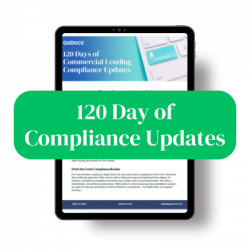Enhancing CRE Asset Management
Asset management and rigorous risk assessment have become more critical than ever in commercial real estate (CRE) lending. Recently, GoDocs’ Mark Rothschild attended the ABA Risk and Compliance Conference in Seattle, where he sat in on the “2024 Approach to Deepen Your Analysis and Managing CRE Assets” panel with Neena Miller, Chief Credit Officer at OceanFirst Bank, and John Markovich, Chief Credit Officer at FirstBank. The panel shed light on the nuanced strategies that community banks are employing to navigate the complexities of today’s market.
Dive into Mark’s summary which includes insights on market trends and industry perspectives shared by Ren Hayhurst, Vice President of Strategy & Partnerships at GoDocs.
Targeted Focus on Asset Classes and Sub-Sectors
Both Miller and Markovich stressed the significance of monitoring specific asset classes and sub-sectors. At FirstBank, Markovich is focusing on observing trends in the office and life science sectors, considering factors like market softening and oversupply issues. Meanwhile, OceanFirst Bank is conducting assessments of their office properties through physical visits to gain a firsthand understanding of occupancy rates for improved asset performance evaluation.
For both banks a significant part of their construction portfolios involves projects, multi-family projects, which require careful supervision due to varying costs and interest rates. With interest rates hovering around 7-8% for loans maturing in the next 18 months, OceanFirst Bank and FirstBank are gearing up for market changes to ensure the resilience of their portfolios.
Market Insights
“We are seeing smaller commercial buildings, such as medical offices, exhibit higher resilience with a lower risk of default compared to larger developments. This stability makes them attractive assets for community banks, especially amidst softening markets for life science and traditional office spaces. Small commercial properties, with a default risk of around 5%, remain robust areas for community bank lending. Conversely, larger buildings, with a 25% default risk, present greater challenges, underscoring the need for meticulous asset selection and management.”
-Ren Hayhurst
GoDocs, VP of Business Strategies,
General Counsel
Commercial Lending Compliance on Autopilot
Don’t let compliance create delays in your lending process. Get our free whitepaper now and start easing the compliance burden with GoDocs.
Comprehensive Risk Management Strategies
Emphasizing the importance of risk management strategies, both financial institutions prioritize stress testing to anticipate and address potential issues early on. Utilizing third-party software for data governance and portfolio monitoring allows them to maintain a view of their performance metrics.
Additionally, FirstBank adopts a faceted approach that includes in depth discussions with market leaders to grasp regional performance nuances. This detailed analysis enables them to customize their tactics based on contexts thereby strengthening their risk management practices.
The Stability of Community Banks
The steadfast nature of community banks highlighted by these lenders highlights their loan evaluation processes and proactive management approaches. Unlike entities that may offload underperforming loans, community banks maintain healthier portfolios through ongoing oversight and prompt intervention in cases of early defaults.
Market Insights
“Diligent data collection and governance enable lenders to spot potential issues early and work with borrowers to strengthen credit before defaults occur. This proactive approach decreases the need to sell underperforming assets, which helps to maintain the overall health and stability of a bank’s loan portfolios. In addition, using third-party loan and market tracking software, as well as conducting more frequent physical inspections of potentially risky collateral properties, enables lenders to monitor loan performance in their entire portfolio more closely and comprehensively.”
-Ren Hayhurst
GoDocs, VP of Business Strategies,
General Counsel
Market Dynamics and Competitive Pressures
Furthermore, market dynamics play a role in shaping production levels and competitive strategies. OceanFirst Bank has adjusted its goals to align with lower customer demand, particularly with commercial and industrial (C&I) loans. The competition from banks offering attractive deal terms presents a challenge for community banks aiming to secure new business profitably.
FirstBank is moving towards deals with syndications and participations, indicating a trend of opportunistic investors eyeing struggling office buildings. This cautious strategy reflects the approach that community banks take in managing their portfolios.
Conclusion
In summary, the insights shared by Neena Miller and John Markovich shed light on the tactics employed by community banks to effectively handle CRE assets. By conducting stress tests, closely monitoring portfolios, and engaging in communication with borrowers, these financial institutions are navigating the current market conditions with agility and foresight. As competitive pressures mount and market dynamics shift, the diligence and stability exhibited by community banks will play a role in sustaining their success and bolstering their communities.
Experience the Future of Commercial Loan Document Automation
Discover GoDocs, the leading SaaS solution powered by the sharpest legal minds in CRE! Schedule a demo today to elevate your lending process and to gain your competitive advantage.

